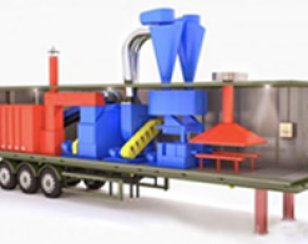Basic foundations
Drying
Dispersed materials drying is a difficult physicochemical process. During drying there is a humidity removal from materials by its evaporation and generated fume extraction. As a rule, materials drying takes place in special apparatus – dryers.
Basically, dryers are classified into method of heat application to dryable materials surfaces.
There are contact, convection, radiation, sublimation, high-frequency and combination dryers.
Convection dryers are more effective for dispersed materials, where constant contact of desiccated agent with surface of materials particles takes place.
Drying speed depends on desiccated agent temperature, relative velocity of its motion, specific surface of dryable particles, physical properties of material.
During initial period (period of drying constant speed) material humidity is constant at large. After drying period, when humidity concentration decreases as a result of evaporation on the material surface, moisture begins moving from the particle centre to the surface owing to concentration gradient, the period of descending drying speed comes, material temperature begins increasing. When material moisture load decreases, temperature of dryable particles is approaching to temperature of desiccant agent. Thus, there is a temperature limit of used dryable agent since there is a possibility of inflammation or other material destruction, especially fine-dispersed one (for example, wood or peat particles).
It’s more difficult to dry lumpy material, because there is more energy for evaporation from particles, than from its surfaces. The less material particles size are, the easier dry them.
Material residence time in dryer should be equal (of more than) necessary drying time to necessary humidity.
The velocity of drying agent in drum driers, band, with "boiling" layer and aero fountain ones is limited by particles terminal velocity and is 0,5-2,0 m/s. In the case of increasing the rate of dryable agent motion, particles will be carried from the dryers in wet condition.
Compliance of environment characteristics with mechanism of moisture transfer or with kinetic peculiarities of drying process should be assured and possibility of material destruction over a period of the whole process should be excepted.
The main difficulties in effective dryers making is a temperature limit of dryable agent, velocity limit of dryable agent and heterogeneous breakup of dryable material.
Grinding
Grinding is a complex process, on which a lot of factors effect and its result is not only dispersion, but also considerable physicochemical properties changing of high dispersed powders. Energy consumption for extreme plastic deformation increases as particle sizes loss, and physicochemical properties changing becomes the main grinding technological result in many cases.
The main method of materials destruction: under grinding bodies and material pieces (revolving, jar and jet mills, roll and other breakers); under environment liquid or gas (electrohydraulic crushers, cavitation mills, ultrasonic crushers).
Mills differ in its purposes: some of them are used for coarse grinding (crushing), others – for fine grinding (dispersion). Every grinder considering its equipment peculiarities is appropriate for a certain dispersion range of grinded material, reaching it grinding is the most effective and economical.
Elementary methods of destruction proceed by making extreme stress by breaking, squeezing, stroke or shear in material particles. Operating mills efficiency, economy (it’s important for industrial using) and dispersion range, where they are the most effective, depend on a lot of factors. Among them utilized materials, separation methods, associated aggregates of loading and unloading requirements, grinded material requirements (humidity, dispersion etc) have great importance.
In most cases raw materials pre-grinding in order to smooth breakup makes some difficulties owing to mills design philosophy. Basically, finished product separation makes using sieve or other separators. During separation by using sieve wet particles stick to sieve and material ejection from grinding zone is stopped, and during separation by air separator grinded, but wet particles return to grinding zone – it decreases grinder efficiency.
The main difficulties and goal of making grinders: separation methods, associated aggregates of loading and unloading requirements, grinded material requirements (humidity, dispersion etc).
|
|
|
|

